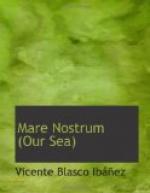In course of time a sea-anemone comes along and attaches itself to the calcareous peak, the number often amounting to five or six, although there is no bodily relation between the paguro and the organisms on top. They are simply partners with a reciprocal interest. The animal-plants sting like nettles; all the monsters without a shell flee from the poison of their tingling organs, and the fragments of their hair burn like pins of fire. In this manner the humble paguro, carrying upon his back his tower crowned with formidable batteries, inspires terror in the gigantic beasts of the deep. The anemones on their part are grateful to him for being thus able to pass incessantly from one side to the other, coming in contact with every class of animals. In this way, they can eat with greater facility than their sisters fixed on the rocks; for they do not have to wait, as the others must, until food drifts casually to their tentacles. Besides this, there is always floating on top some of the remains of the booty that the crafty crab in his wandering impunity has gathered below.
Ferragut, on passing from one tank to the other, mentally established the gradation of the fauna from the primitive protoplast to the perfect organism.
The sponges of the Mediterranean swam as soon as they were born, when they were like pin-heads, with vibratory movements. Then they remained immovable, the water filtering through the cracks and crannies of their texture, protecting their delicate flesh with a bristling of spikes,—sharp limestone needles with which they pierced the passing fishes and rendered them immovable, availing themselves of the nourishment of their putrefying remains.
The nettles of the sea spread out their stinging threads by the thousands, discharging a venom that stupefies the victim and makes him fall into their corolla. With unlimited voracity, and fastened to the rocks, they overpower fish much larger than they, and at the first hint of danger shrink together in such a way that it is very difficult to see them. The sea-plumes lie flabby and dark as dead animals, until absorbing water, they suddenly rear themselves up, transparent and full of leaves. Thus they go from one side to the other, with the lightness of a feather, or, burrowing in the sand, send forth a phosphoric glow. The belles of the sea, the elegant Medusae, open out the floating circle of their fragile beauty. They are transparent fungi, open umbrellas of glass that advance by means of their contractions. From the inner center of their dome hangs a tube equally transparent and gelatinous,—the mouth of the animal. Long filaments depend from the edges of their circular forms, sensitive tentacles that at the same time maintain their floating equilibrium.
These fragile beings, that appear to belong to an enchanted fauna, white as rock crystal with soft borders of rose color or violet, sting like nettles and defend themselves by their fiery touch. Some subtle and colorless parasols were living here in the tank under the protection of a second enclosure of crystal, and their mucous mistiness scarcely showed itself within this bell-shaped glass except as a pale line of blue vapor.




